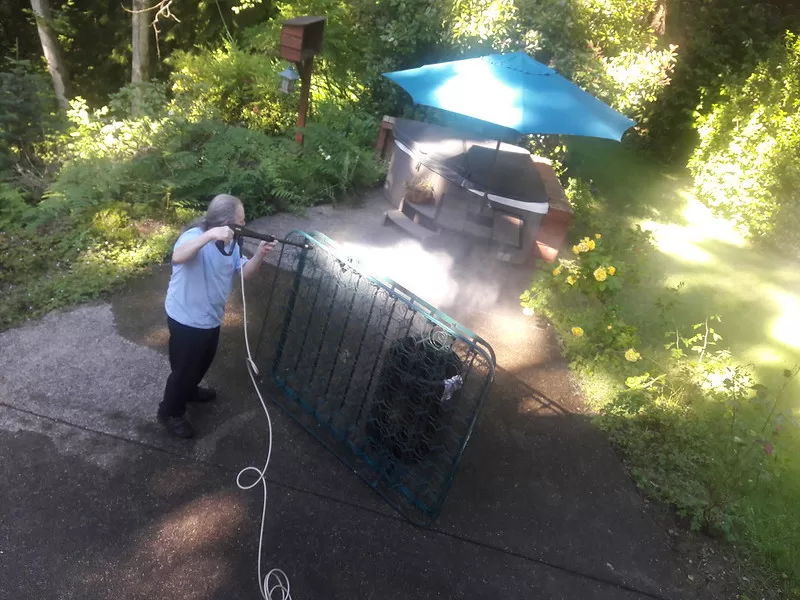Unlock the power of pristine surfaces with our comprehensive guide, “10 Secrets to Successful Pressure Washing.” In this expertly crafted resource, we delve deep into the world of pressure washing, revealing the hidden gems of knowledge that will elevate you’re cleaning endeavors to a whole new level.

Whether you’re a beginner looking to master the art of pressure washing or an experienced enthusiast seeking to refine your techniques, these secrets will pave the way to exceptional results.
Follow this guide about the tips, tricks, and strategies that professionals use to achieve spotless surfaces and bring back the beauty of your home or property.
Before starting any pressure washing project, carefully assess the surface you intend to clean. Determine the material, condition, and any specific cleaning requirements. Different surfaces, such as concrete, wood, or vinyl, may necessitate different pressure settings, cleaning solutions, and techniques. Understanding the surface will help you tailor your approach for optimal results.
Invest in a high-quality pressure washer that suits your needs. Consider factors such as pressure output, water flow rate, and nozzle attachments.
A pressure washer with adjustable pressure settings allows you to customize the force to match the surface you’re cleaning. Don’t forget to use appropriate safety gear, including goggles, gloves, and non-slip footwear, to protect yourself during the process.
Read Also:
For tough stains, pre-treating the surface can significantly enhance cleaning results. Use a suitable cleaning solution or detergent to break down grease, oil, mildew, or other stubborn substances. Allow the solution to sit for a few minutes before pressure washing to ensure maximum effectiveness.
Maintaining a consistent distance between the pressure washer nozzle and the surface is crucial for even cleaning and preventing damage.
Hold the nozzle approximately 12 to 18 inches away from the surface and adjust the distance as needed based on the pressure and surface sensitivity. Avoid holding the nozzle too close, as it can cause etching or gouging.
Adopting the right technique is essential for successful pressure washing. Move the nozzle in a sweeping motion, overlapping each pass to ensure thorough cleaning. Start with low pressure and gradually increase it if necessary.
Clean from top to bottom to prevent streaking, and pay attention to corners and crevices that may require additional care.
Divide larger areas into manageable sections to ensure thorough cleaning. Cleaning in smaller sections allows you to focus on one area at a time, preventing missed spots or incomplete cleaning. It also helps you maintain control and avoid fatigue during extended cleaning sessions.
Proper water flow is essential for effective pressure washing. Ensure a steady water supply and check for any clogs or blockages in the hose or nozzle. Optimize the water flow rate according to the surface and cleaning requirements, as too much or too little water can affect the cleaning results.
Take precautions to protect surrounding areas from potential damage. Cover delicate plants, electrical outlets, and any objects that may be sensitive to water or pressure. Use plastic sheeting or tarps to shield nearby surfaces from overspray or debris. These measures will help safeguard your property and prevent unintended harm during the cleaning process.
Proper maintenance of your pressure washing equipment is essential for longevity and optimal performance. Clean the nozzle and filters regularly, inspect hoses for any signs of wear or damage, and follow the manufacturer’s guidelines for maintenance. Storing the equipment in a clean and dry area when not in use will help prevent corrosion and extend its lifespan.
Always prioritize safety when pressure washing. Familiarize yourself with the equipment’s safety features and operating instructions. Avoid pointing the nozzle at yourself or others, and never spray the pressure washer directly at electrical outlets or components. Be mindful of your surroundings and take necessary precautions to prevent accidents or injuries.
What is pressure washing, and how does it work?
Pressure washing is a cleaning method that utilizes a high-pressure stream of water to remove dirt, grime, mold, and other contaminants from various surfaces. It works by forcefully directing water through a narrow nozzle, effectively blasting away dirt and stains.
Is pressure washing safe for all surfaces?
No, pressure washing is not safe for all surfaces. While it is effective on hard and durable surfaces like concrete, brick, and some types of wood, it can damage more delicate materials like siding, roofing, and painted surfaces. It’s crucial to assess the surface and adjust the pressure accordingly.
Do I need any special equipment for pressure washing?
Yes, you will need a pressure washer, which can be either gas-powered or electric, and appropriate nozzles for different tasks. Additionally, safety gear like goggles and gloves is essential to protect yourself from the high-pressure water.
How can I remove stubborn stains or mold during pressure washing?
For tough stains or mold, consider using specialized detergents or cleaning solutions designed for pressure washers. Pre-treating the area with these products before pressure washing can significantly enhance the cleaning process.
What are some safety precautions to follow when pressure washing?
Safety is paramount when pressure washing. Always wear protective gear, including goggles, gloves, and sturdy footwear. Be cautious around electrical outlets and connections.
Avoid pointing the nozzle at people, pets, or delicate items, as the high pressure can cause injury or damage. Finally, read the manufacturer’s instructions for your pressure washer thoroughly before use.
Mastering the art of pressure washing requires a combination of technique, knowledge, and attention to detail. By assessing the surface, choosing the right equipment, and adopting proper techniques, you can achieve successful cleaning results.
Remember to pre-treat stubborn stains, maintain a consistent distance, and clean in sections for thoroughness. Protect surrounding areas, prioritize safety, and perform regular equipment maintenance.
By following these ten secrets, you’ll unlock the true power of pressure washing and enjoy a clean, rejuvenated space that shines with brilliance.